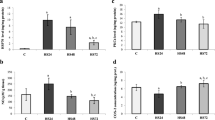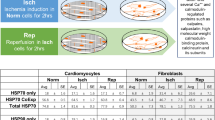Abstract
Cardiac surgery is usually performed under conditions of cardioplegicischemic arrest. To protect the heart during the ischemic period, themyocardium is exposed to varying degrees of hypothermia. Althoughhyperthermia is known to induce the heat shock response, the moleculareffects of hypothermia on the myocardium have not been investigated. We havestudied the effect of hypothermia on the induction of heat shock proteins inprimary cultures of neonatal cardiomyocytes. Cold stress in cardiomyocytesinduced a 6 fold increase in the heat shock protein HSP70 as compared tocontrol. Increased HSP70 protein levels correlated with induction of HSP70mRNAs. Maximal levels of HSP70 protein appeared 4-6 h following recoveryfrom cold shock, indicating the transient nature of the response. Inductionof HSP25 mRNA was also observed in cold-shocked cardiomyocytes, even thoughincreased HSP25 protein levels were not detected. Our results indicate thathypothermia is capable of inducing the heat shock response in neonatalcardiomyocytes.
Similar content being viewed by others
References
Mauney MC, Kron IL: The physiologic basis of warm cardioplegia. Ann Thorac Surg 60: 819–823, 1995
Subjeck JR, Sciandra JJ, Johnson RJ: Heat shock proteins and thermotolerance; A comparison of induction kinetics. Br J Radiol 55: 579–584, 1982
Li GC, Werb Z: Correlation between synthesis of heat shock proteins and development of thermotolerance in Chinese hamster fibroblasts. Proc Natl Acad Sci USA 79: 3218–3222, 1982
Angelidis CE, Lazaridis I, Pagoulatos GN: Constitutive expression of heat-shock protein 70 in mammalian cells confers thermoresistance. Eur J Biochem 199: 35–39, 1991
Li GC, Li L, Liu RY, Rehman M, Lee WM: Heat shock protein hsp70 protects cells from thermal stress even after deletion of its ATP-binding domain. Proc Natl Acad Sci USA 89: 2036–2040, 1992
Donnelly TJ, Sievers RE, Bissern FL, Welch WJ, Wolfe CL: Heat shock protein induction in rat hearts. A role for improved myocardial salvage after ischemia and reperfusion? Circulation 85: 769–778, 1992
Currie RW, Tanguay RM, Kingma JJ: Heat-shock response and limitation of tissue necrosis during occlusion/reperfusion in rabbit hearts. Circulation 87: 963–971, 1993
Marber MS, Latchman DS, Walker JM, Yellon DM: Cardiac stress protein elevation 24 hours after brief ischemia or heat stress is associated with resistance to myocardial infarction. Circulation 88: 1264–1272, 1993
Currie RW: Protein synthesis in perfused rat hearts after in vivohyperthermia and in vitrocold ischemia. Biochem Cell Biol 66: 13–19, 1988
Yellon DM, Pasini E, Cargnoni A, Marber MS, Latchman DS, Ferrari R: The protective role of heat stress in the ischaemic and reperfused rabbit myocardium. J Mol Cell Cardiol 24: 895–907, 1992
Amrani M, Allen NJ, O'shea J, Corbett J, Dunn MJ, Tadjkarimi S, Theodoropoulos S, Pepper J, Yacoub MH: Role of catalase and heat shock protein on recovery of cardiac endothelial and mechanical function after ischemia. Cardioscience 4: 193–198, 1993
Walker DM, Pasini E, Kucukoglu S, Marber MS, Iliodromitis E, Ferrari R, Yellon DM: Heat stress limits infarct size in the isolated perfused rabbit heart. Cardiovasc Res 27: 962–967, 1993
Marber MS, Mestril R, Chi SH, Sayen MR, Yellon DM, Dillmann WH: Overexpression of the rat inducible 70 kD heat stress protein in a transgenic mouse increases the resistance of the heart to ischemic injury. J Clin Invest 95: 1446–1456, 1995
Plumier JC, Ross BM, Currie RW, Angelidis CE, Kazlaris H, Kollias G, Pagoulatos GN: Transgenic mice expressing the human heat shock protein 70 have improved post-ischemic myocardial recovery. J Clin Invest 95: 1854–1860, 1995
Holland DB, Roberts SG, Wood EJ, Cunliffe WJ: Cold shock induces the synthesis of stress proteins in human keratinocytes. J Invest Dermatol 101: 196–199, 1993
Liu AY, Bian H, Huang LE, Lee YK: Transient cold shock induces the heat shock response upon recovery at 37°C in human cells. J Biol Chem 269: 14768–14775, 1994
Matz JM, Blake MJ, Tatelman HM, Lavoi KP, Holbrook NJ: Characterization and regulation of cold-induced heat shock protein expression in mouse brown adipose tissue. Am J Physiol 269: R38–R47, 1995
Parkes JG, Hussain RA, Olivieri NF: Templeton DM: Effects of iron loading on uptake, speciation, and chelation of iron in cultured myocardial cells. J Lab Clin Med 122: 36–47, 1993
Bradford MM: A rapid and sensitive method for the quantitation of microgram quantities of protein utilizing the principle of protein-dye binding. Anal Biochem 72: 248–254, 1976
Chomczynski P, Sacchi N: Single-step method of RNA isolation by acid guanidinium thiocyanate-phenol-chloroform extraction. Anal Biochem 162: 156–159, 1987
Mestril R, Chi SH, Sayen MR, Dillmann WH: Isolation of a novel inducible rat heat-shock protein (HSP70) gene and its expression during ischaemia/hypoxia and heat shock. Biochem J 3: 561–569, 1994
Gaestel M, Gross B, Benndorf R, Strauss M, Schunk WH, Kraft R, Otto A, Bohm H, Stahl J, Drabsch H, Bielka H: Molecular cloning, sequencing and expression in Escherichia coliof the 25 kDa growthrelated protein of Ehrlich ascites tumor and its homology to mammalian stress proteins. Eur J Biochem 179: 209–213, 1989
Feinberg AP, Vogelstein B: A technique for radiolabeling DNA restriction endonuclease fragments to high specific activity. Anal Biochem 132: 6–13, 1983
Landry J, Bernier D, Chretien P, Nicole LM, Tanguay RM, Marceau N: Synthesis and degradation of heat shock proteins during development and decay of thermotolerance. Cancer Res 42: 2457–2461, 1982
Fremes SE, Weisel RD, Mickle DA, Ivanov J, Madonik MM, Seawright SJ, Houle S, McLaughlin PR, Baird RJ: Myocardial metabolism and ventricular function following cold potassium cardioplegia. J Thorac Cardiovasc Surg 89: 531–546, 1985
Morris SD, Cumming DVE, Latchman DS, Yellon DM: Specific induction of the 70 kD heat stress proteins by the tyrosine kinase inhibitor herbimycin-a protects rat neonatal cardiomyocytes. J Clin Invest 97: 706–712, 1996
Xu Q, Ganju L, Fawcett TW, Holbrook NJ: Vasopressin-induced heat shock protein expression in renal tubular cells. Lab Invest 74: 178–187, 1996
Berbers GA, Kunnen R, van Bergen en Henegouwen PM, van Wijk R: Localization and quantitation of hsp84 in mammalian cells. Exp Cell Res 177: 257–271, 1988
Quraishi H, Brown IR: Expression of heat shock protein 90 (hsp90) in neural and nonneural tissues of the control and hyperthermic rabbit. Exp Cell Res 219: 358–363, 1995
Clark BD, Brown IR: Protein synthesis in the mammalian retina following the intravenous administration of LSD. Brain Res 247: 97–104, 1982
Arrigo AP, Suhan JP, Welch WJ: Dynamic changes in the structure and intracellular locale of the mammalian low-molecular-weight heat shock protein. Mol Cell Biol 8: 5059–5071, 1988
Currie RW, Tanguay RM: Analysis of RNA transcripts for catalase and SP71 in rat hearts after in vivohyperthermia. Biochem Cell Biol 69: 375–382, 1991
Weinstein SP, Haber RS: Differential regulation of glucose transporter isoforms by thyroid hormone in rat heart. Biochem Biophys Acta 1136: 302–308, 1992
King L, Weber G: Conformational drift and cryoinactivation of lactate dehydrogenase. Biochemistry 25: 3637–3640, 1986
Pain RH: Temperature and macromolecular structure and function. Symp Soc Exp Biol 41: 21–33, 1987
Watson PF, Morris GJ: Cold shock injury in animal cells. Symp Soc Exp Biol 41: 311–340, 1987
Ananthan J, Goldberg AL, Voellmy R: Abnormal proteins serve as eukaryotic stress signals and trigger the activation of heat shock genes. Science 232: 522–524, 1986
Author information
Authors and Affiliations
Rights and permissions
About this article
Cite this article
Laios, E., Rebeyka, I.M. & Prody, C.A. Characterization of cold-induced heat shock protein expression in neonatal rat cardiomyocytes. Mol Cell Biochem 173, 153–159 (1997). https://doi.org/10.1023/A:1006844114348
Issue Date:
DOI: https://doi.org/10.1023/A:1006844114348




